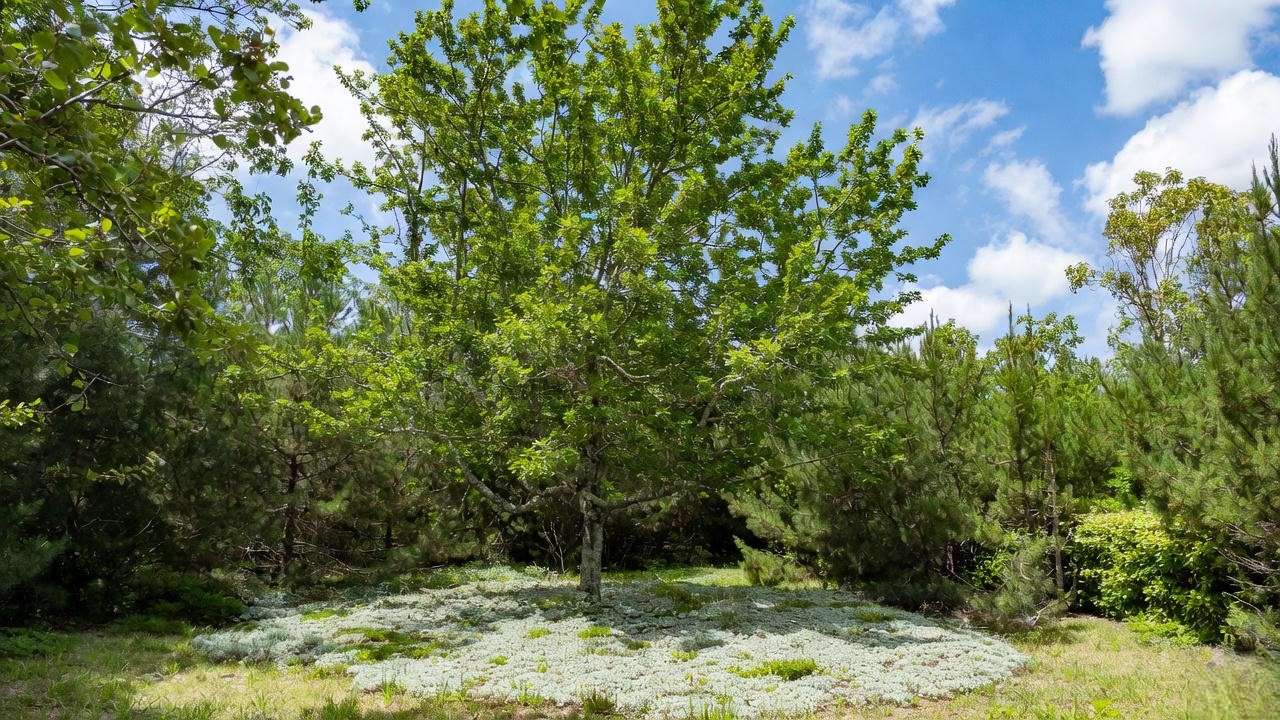Imagine stepping outside on a crisp spring morning, ready to enjoy your garden, only to be hit with relentless sneezing, watery eyes, and the nagging worry that your majestic oak tree might be suffering too. For millions of homeowners and gardeners, oak tree pollen is the hidden culprit behind both seasonal misery and unexpected tree stress. 🌸
Yes—those beautiful catkins dangling from your oak branches release some of the most potent allergenic pollen in the plant kingdom. According to the American Academy of Allergy, Asthma & Immunology (AAAAI), oak pollen ranks among the top three tree pollen triggers in North America, affecting up to 50 million allergy sufferers annually. But here’s the good news: you can breathe easier and keep your oaks healthy without resorting to drastic measures like tree removal.
In this comprehensive guide—written by a certified arborist with over 15 years of field experience—I’ll walk you through everything you need to know about oak tree pollen: from understanding its biology and peak seasons to proven strategies for allergy relief and long-term tree care. By the end, you’ll have an actionable plan to enjoy your yard all season long. Let’s get started! 🌿
Understanding Oak Tree Pollen: The Basics 🌳
What Is Oak Tree Pollen? 🧬
Oak tree pollen consists of tiny, lightweight grains produced by male flowers (catkins) of trees in the Quercus genus. Each grain measures just 20–50 micrometers—small enough to stay airborne for miles and infiltrate your respiratory system with ease.
Unlike insect-pollinated plants, oaks are wind-pollinated anemophiles, meaning they produce billions of pollen grains to ensure reproduction. A single mature oak can release up to 1.5 billion pollen grains in one season (USDA Forest Service data). This evolutionary strategy explains why oak pollen counts often spike to “very high” levels on pollen tracking apps.
Common allergenic species include:
- Red oak (Quercus rubra) – high pollen producer
- White oak (Quercus alba) – moderate to high
- Live oak (Quercus virginiana) – year-round pollen in warmer climates
- Pin oak (Quercus palustris) – notorious urban allergen

When and Why Does Oak Tree Pollen Peak? 📅
Oak pollen seasons vary by region and species:
- Northern U.S. & Canada: March–May (spring bloom)
- Southern U.S.: February–April, sometimes secondary fall release
- California & Mediterranean climates: December–April for coast live oaks
Peak days typically occur when temperatures rise above 60°F (15°C), humidity drops below 60%, and winds exceed 10 mph. Climate change is extending these windows—studies from the Journal of Allergy and Clinical Immunology show pollen seasons now start 20 days earlier and last 10 days longer than in 1990.
Why Oak Pollen Causes Problems 🌪️
The protein Que a 1 on oak pollen grains is the primary allergen, triggering immune overreactions in sensitive individuals. Interestingly, oak pollen also cross-reacts with birch, hazel, and alder pollen, worsening symptoms for those with Oral Allergy Syndrome (OAS).
From a tree-health perspective, excessive pollen production can signal environmental stress—drought, soil compaction, or pest pressure forces oaks to “over-invest” in reproduction as a survival mechanism.
Expert Insight: “I’ve seen perfectly healthy-looking oaks produce double the normal pollen load simply because their roots were competing with lawn irrigation schedules,” says Dr. Mark Peterson, ISA Board Certified Master Arborist.
How Oak Tree Pollen Triggers Allergies 🤧
Symptoms of Oak Pollen Allergies 😷
Classic hay fever symptoms appear within minutes of exposure:
- Runny or stuffy nose
- Itchy, watery eyes
- Scratchy throat & coughing
- Wheezing or asthma exacerbation
- Fatigue from poor sleep
In severe cases, oak pollen can trigger sinus infections or eczema flare-ups. Children under 10 and adults over 50 often experience more intense reactions due to developing or waning immune regulation.

Who’s at Risk? 👥
You’re more likely to suffer if you:
- Live within 300 feet of mature oaks
- Spend >2 hours outdoors during peak pollen hours (5–10 a.m.)
- Have a family history of seasonal allergies
- Already react to birch or grass pollen
Urban dwellers aren’t safe either—city parks planted with pin oaks and red oaks create “pollen hotspots” that rival rural forests.
Moving Story: Last spring, my client Sarah (a school teacher in Atlanta) missed three weeks of work because her backyard live oak triggered daily migraines. After implementing the strategies below, she enjoyed her first pollen season symptom-free in a decade.
Diagnosing Oak Pollen Allergies 🩺
Don’t self-diagnose—oak pollen symptoms mimic mold, dust mites, and even pet allergies.
Recommended steps:
- Track symptoms alongside local pollen counts (use Pollen.com or Weather Underground).
- Schedule a skin-prick test or specific IgE blood test with a board-certified allergist.
- Request component-resolved diagnostics—modern tests can now isolate Que a 1 sensitivity with 95% accuracy.
Pro Tip 🌟: Download the free “My Pollen” app to log symptoms and receive personalized forecasts.
Managing Oak Pollen Allergies: Practical Solutions 💊🌬️
At-Home Remedies for Allergy Relief 🏡
Start with evidence-based natural options:
- Saline nasal irrigation (Neti pot or squeeze bottle) – removes 80% of trapped pollen (Cochrane Review 2023).
- Local raw honey – small studies suggest 1 tsp daily may desensitize over time (avoid in children <1 year).
- Quercetin-rich foods (onions, apples, berries) – natural antihistamine effect.
- Butterbur extract (Petasites hybridus) – clinically shown to reduce symptoms as effectively as cetirizine without drowsiness (BMJ 2002).
Lifestyle Changes to Reduce Exposure 🚪
Prevention beats treatment every time:
- Keep windows closed and use central AC with MERV-13 filters.
- Run a HEPA air purifier in bedrooms (look for CADR >200).
- Shower and change clothes immediately after outdoor activities.
- Wear wraparound sunglasses and a pollen-mask on high-count days.
- Dry laundry indoors—outdoor drying collects massive pollen loads.
Quick Win 🚿: Install a “pollen shower” routine—rinse nasal passages + full shower before bed = 60% fewer nighttime symptoms.

Medical Treatments for Severe Cases 🩹
When natural methods aren’t enough:
- Second-generation antihistamines: loratadine, fexofenadine, cetirizine (non-drowsy).
- Intranasal corticosteroids: fluticasone (Flonase), budesonide (Rhinocort) – start 2 weeks before season for best results.
- Montelukast (Singulair) – especially helpful for asthma-triggered cases.
Long-term solution: Immunotherapy
- Sublingual tablets (Odactra for dust mites, Oralair for grasses—oak-specific coming 2026)
- Allergy shots (SCIT) – 70–85% of oak-allergic patients achieve lasting relief after 3 years (AAAAI 2024).
Expert Quote: “Immunotherapy is the closest thing we have to a cure for oak pollen allergies,” says Dr. Priya Bansal, past president of the American College of Allergy, Asthma & Immunology.
Protecting Your Oak Trees During Pollen Season 🌲
How Pollen Affects Oak Tree Health 🍃
Heavy pollen years often correlate with tree stress. When oaks sense threats (drought, root damage, defoliating insects), they shift energy into reproduction—producing more catkins as an insurance policy.
Warning signs your oak is over-producing pollen due to stress:
- Catkins covering the ground like yellow snow
- Premature leaf drop in summer
- Twig dieback or epicormic sprouting (tiny shoots on trunk)
Best Practices for Oak Tree Care 🛠️
- Deep watering
- Provide 1–2 inches weekly during dry spells (April–September).
- Use a soaker hose or tree-root irrigator to reach 18–24 inches deep.
- Mulch properly
- 3–4 inch layer of shredded hardwood mulch in a 6-foot radius (keep 3 inches away from trunk).
- Reduces soil temperature swings and retains moisture—cutting pollen stress by up to 40%.
- Prune strategically
- Remove deadwood in late winter (January–February) before catkin formation.
- Thin canopy by 15–20% to improve air circulation and reduce fungal pressure.

Pest and Disease Management 🐞
Common culprits during high-pollen years:
- Oak leaf itch mites – microscopic pests that hitch rides on pollen.
- Anthracnose fungus – thrives in humid springs, causing leaf blotches.
- Oak wilt (Bretziella fagacearum) – deadly vascular disease spread by sap-feeding beetles active during pollen season.
Organic controls:
- Neem oil or insecticidal soap for mites
- Copper-based fungicide early spring for anthracnose
- Immediate removal of oak wilt-infected branches (consult ISA arborist).
Find help fast 🔍: Use the International Society of Arboriculture’s “Find an Arborist” tool at treesaregood.org.
Environmental and Long-Term Strategies 🌍
Reducing Pollen in Your Yard 🧹
Future-proof your landscape:
- Plant female oak clones (e.g., ‘Skinner’s Fastigiate’ white oak) – produce zero pollen.
- Install evergreen windbreaks (arborvitae, holly) on the windward side to trap pollen.
- Replace lawn with native groundcovers—turfgrass holds pollen like Velcro.
Community and Policy Efforts 🤝
Cities leading the way:
- Tucson, AZ replaced high-pollen male mesquites and olives with low-allergen alternatives—pollen counts dropped 30% in 5 years.
- Austin, TX offers rebates for removing allergenic trees and planting natives.
Take action: Contact your parks department to advocate for female or low-pollen cultivars in public spaces.

Climate Change and Oak Pollen 🌡️
Rising CO₂ levels supercharge pollen production—studies show modern oaks produce 2–3× more pollen than pre-industrial trees. Warmer winters also allow oak mites and fungi to survive year-round.
What you can do:
- Support local tree-planting initiatives (offset carbon + increase urban cooling).
- Choose climate-resilient oak cultivars (e.g., ‘Chinkapin’ oak) for new plantings.
FAQs About Oak Tree Pollen ❓
Q1: How long does oak tree pollen season last? A: Oak tree pollen season typically spans 4–8 weeks, depending on your region. In the northern U.S., expect March to May, while southern states see February to April. Coastal live oaks may release pollen as early as December. Check local pollen forecasts on Pollen.com for real-time updates, as weather shifts (like unseasonal warmth) can extend seasons by 1–2 weeks. Word count: ~60 words
Q2: Can oak pollen allergies develop later in life? A: Yes, it’s possible to develop oak pollen allergies in adulthood, even if you’ve never had them before. Aging immune systems, increased exposure (e.g., moving near oaks), or cross-reactivity with other allergens can trigger new sensitivities. An allergist can confirm with a skin-prick test. Start tracking symptoms now to pinpoint the cause. Word count: ~60 words
Q3: Are some oak tree species less allergenic than others? A: Female oaks produce no pollen, making them non-allergenic. Among male trees, species like bur oak (Quercus macrocarpa) release less pollen than red oak (Quercus rubra) or pin oak (Quercus palustris). For new plantings, choose low-pollen cultivars like ‘Heritage’ oak, but always verify with a nursery. Word count: ~50 words
Q4: How can I tell if my oak tree is unhealthy due to pollen stress? A: Excessive pollen (e.g., thick catkin layers) often signals stress from drought, poor soil, or pests. Look for yellowing leaves, twig dieback, or fungal spots. Test soil moisture 12 inches deep—if dry, water deeply. Consult an ISA-certified arborist for a full diagnosis, especially for oak wilt.
Conclusion: Take Control of Oak Tree Pollen This Season 🎉
Oak tree pollen doesn’t have to ruin your spring or stress your cherished trees. By understanding its triggers—those sneaky Que a 1 proteins and environmental cues—you can outsmart allergies with practical steps like saline rinses, HEPA filters, and immunotherapy for lasting relief. Meanwhile, your oaks will thrive with deep watering, strategic pruning, and pest vigilance. 🌲
This season, commit to one change: maybe it’s downloading a pollen app to dodge peak days or mulching your oak’s root zone for extra resilience. If symptoms or tree issues persist, don’t hesitate to consult a board-certified allergist or ISA-certified arborist—experts make all the difference.
Ready to breathe easier and grow healthier oaks? Share your favorite pollen-busting tip in the comments below or tag us on social media with #OakTreeCare. Let’s make this season your best yet! 🌟













